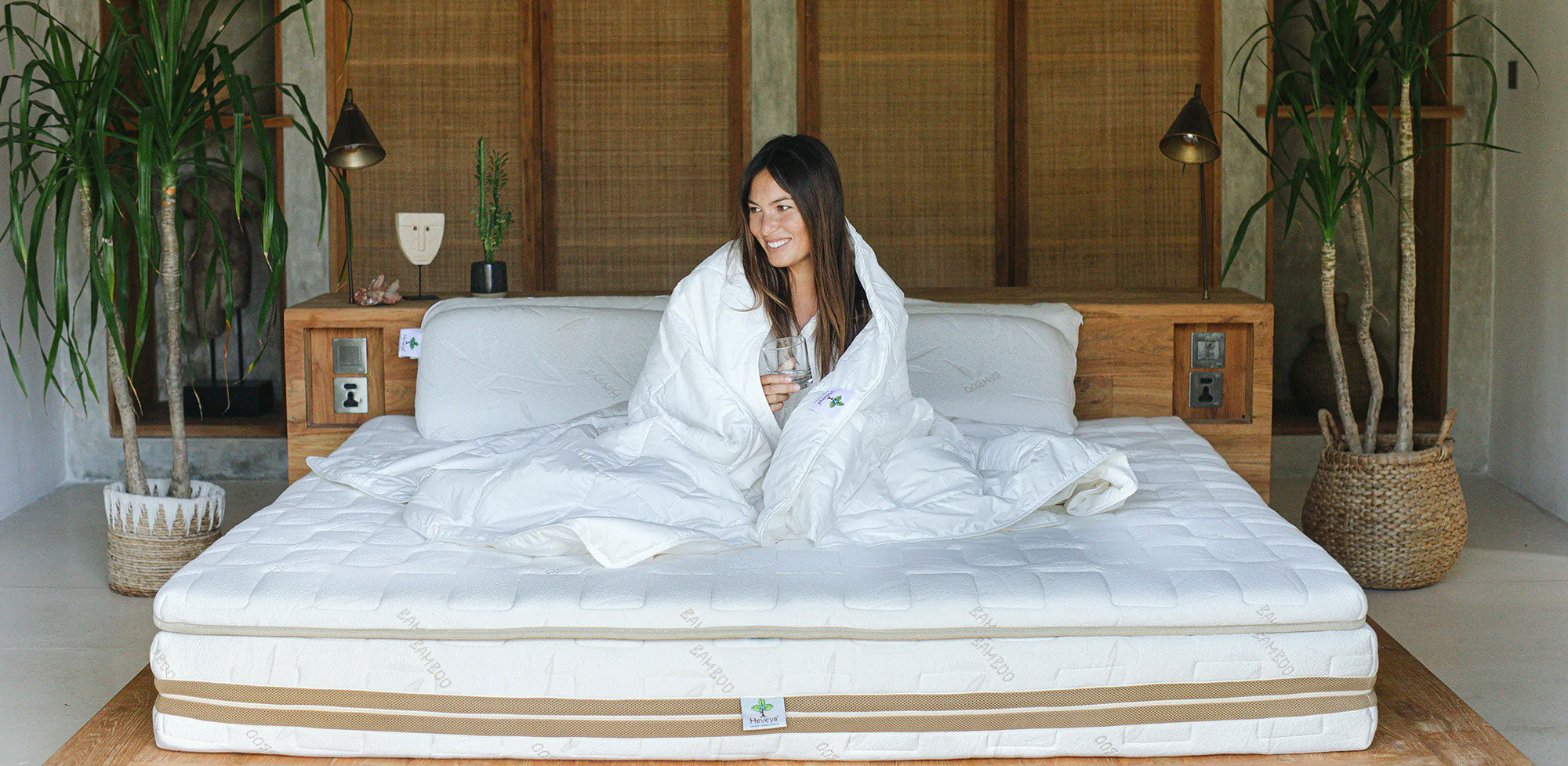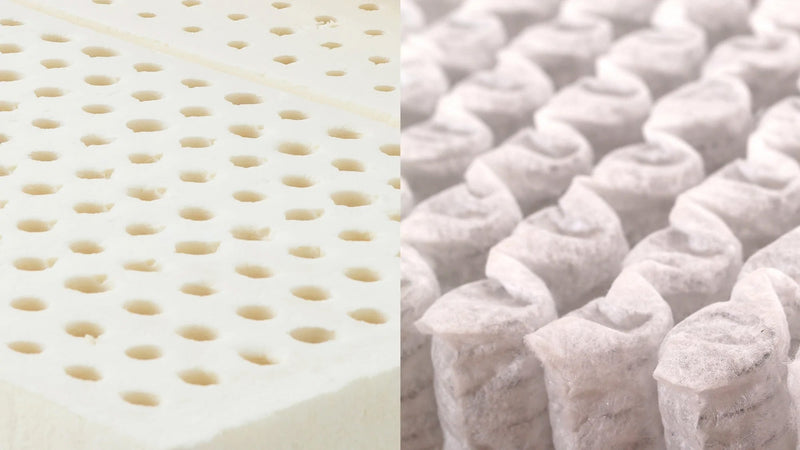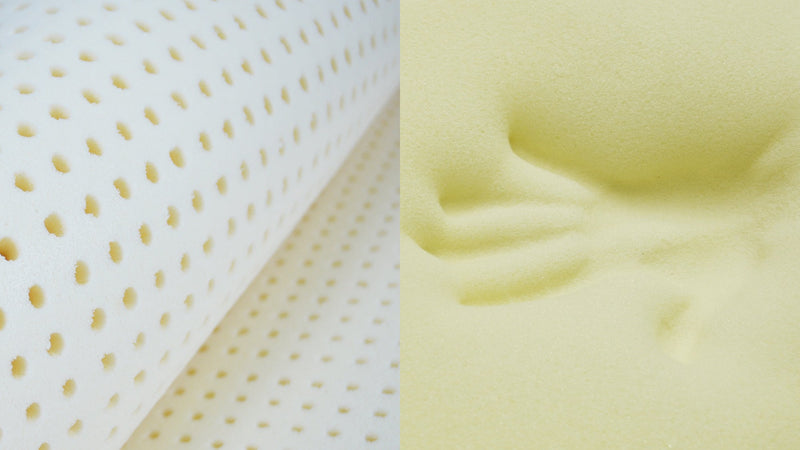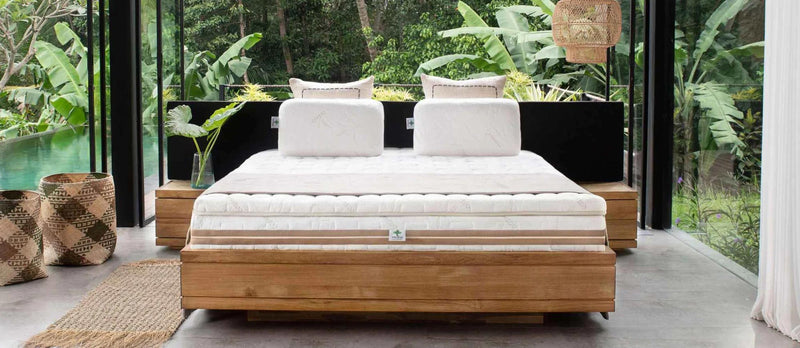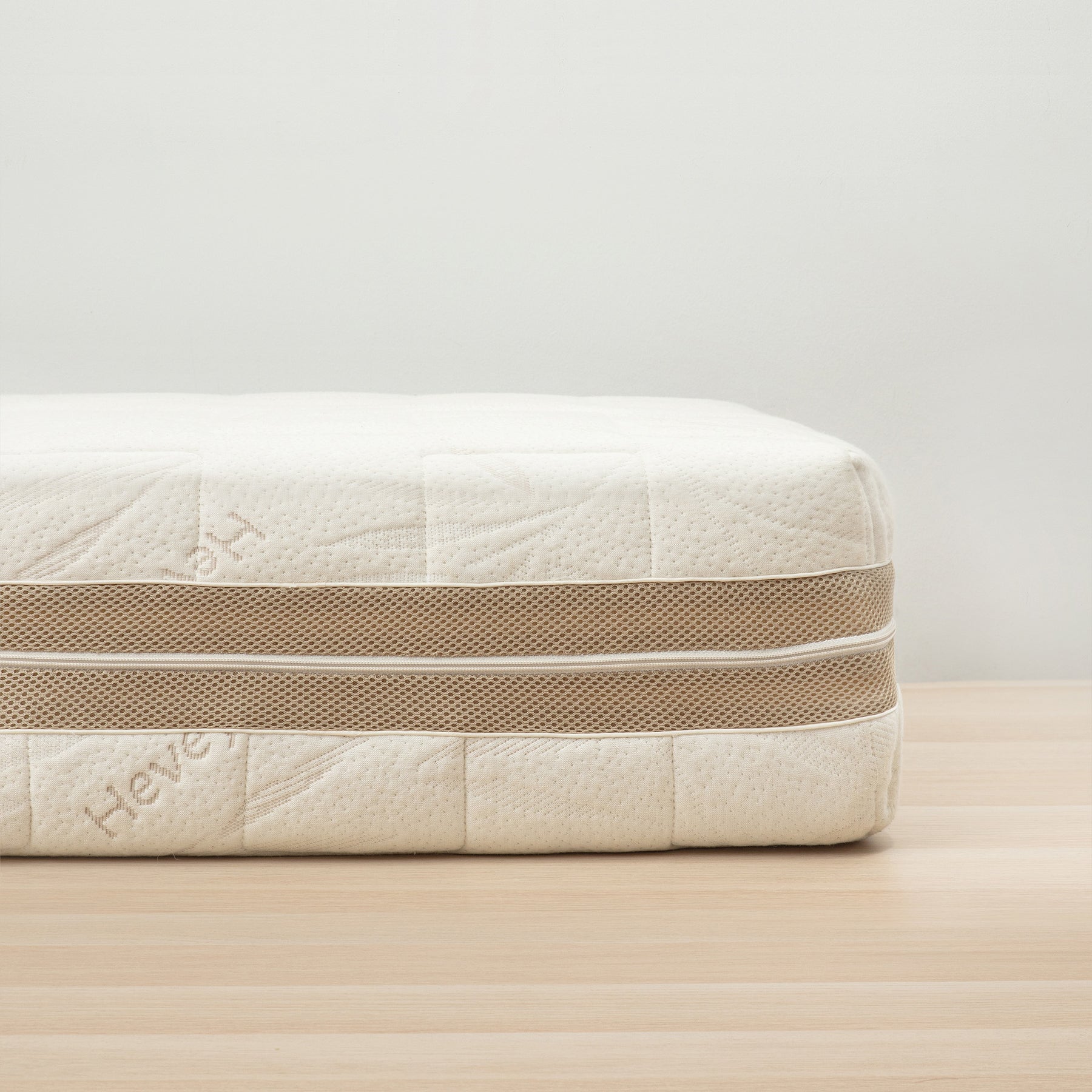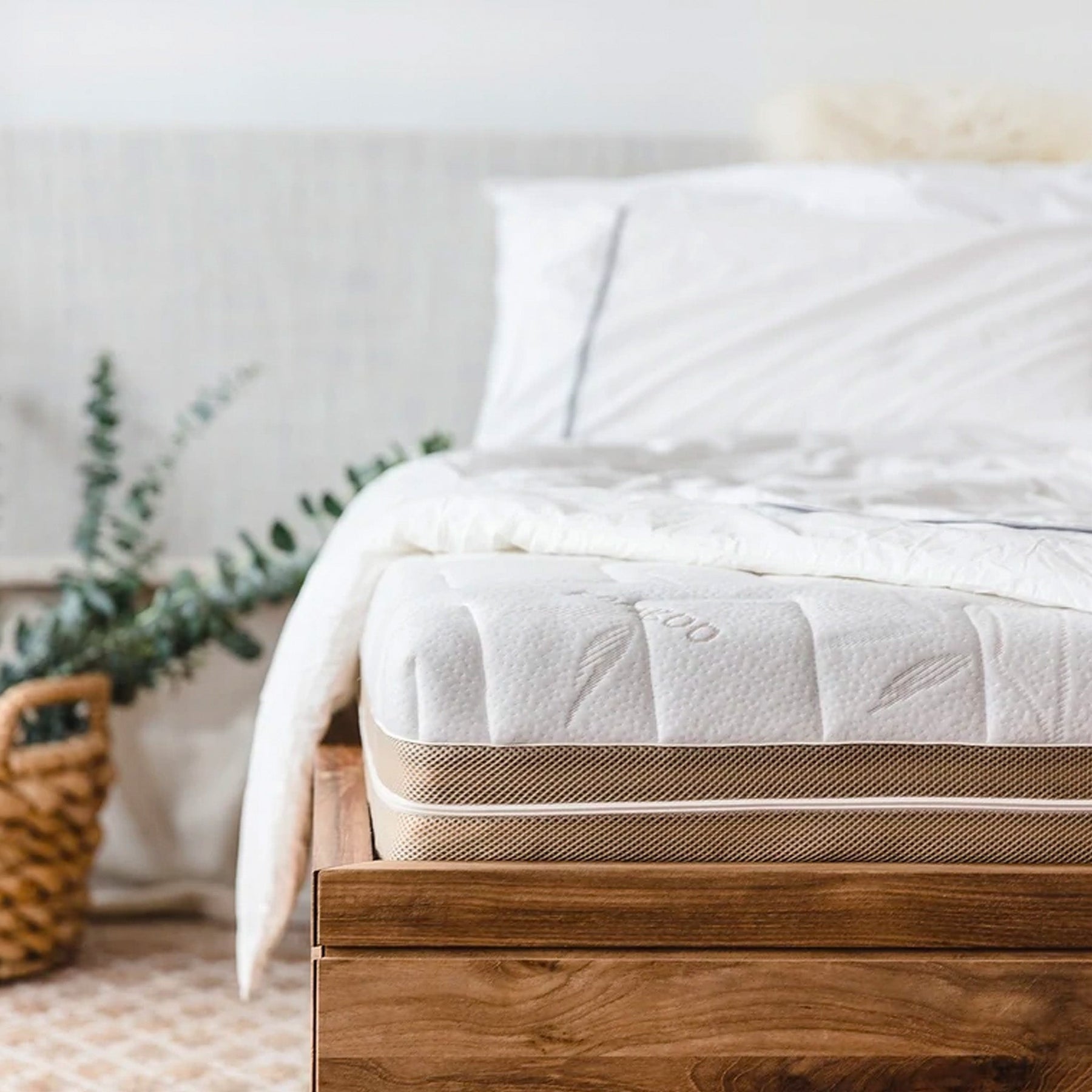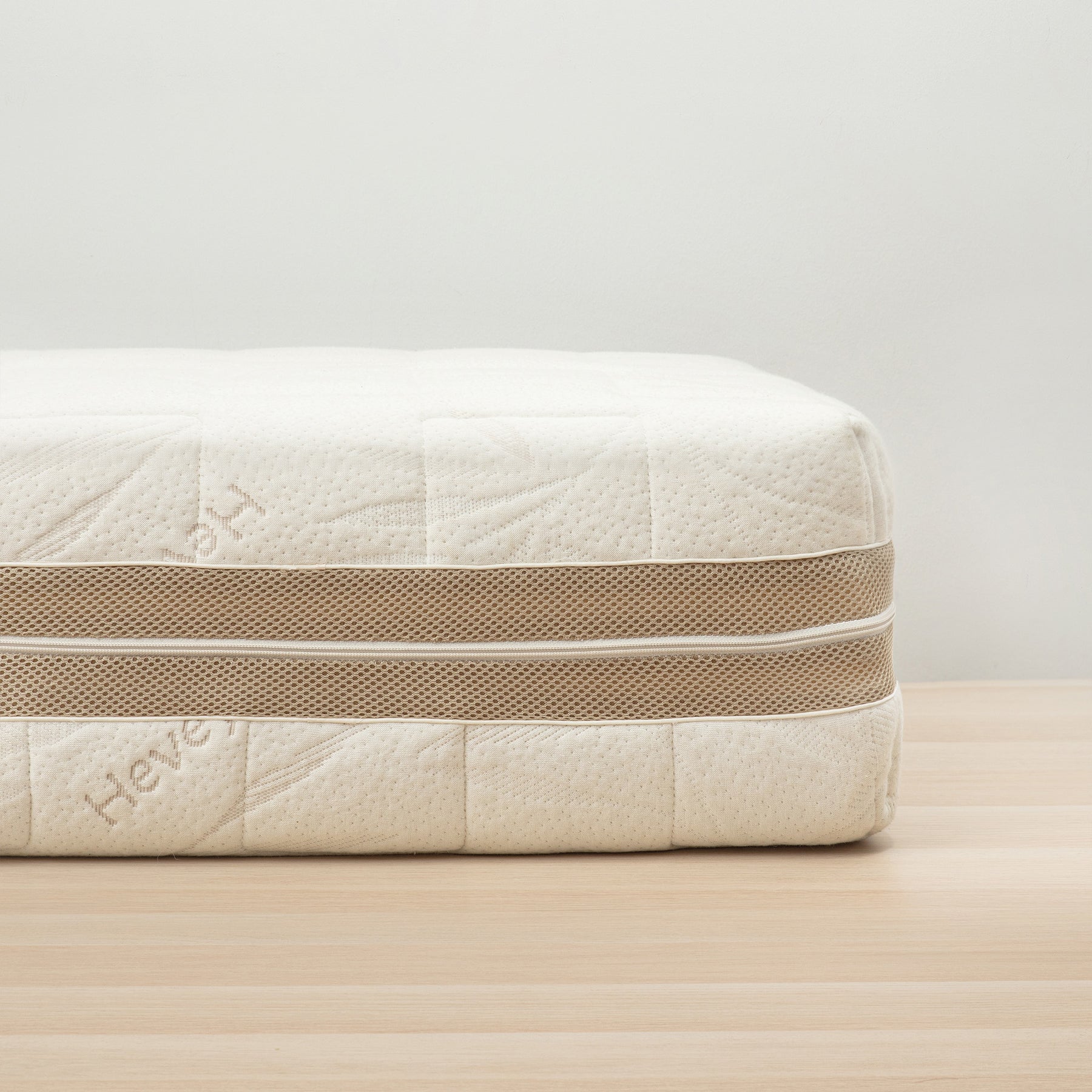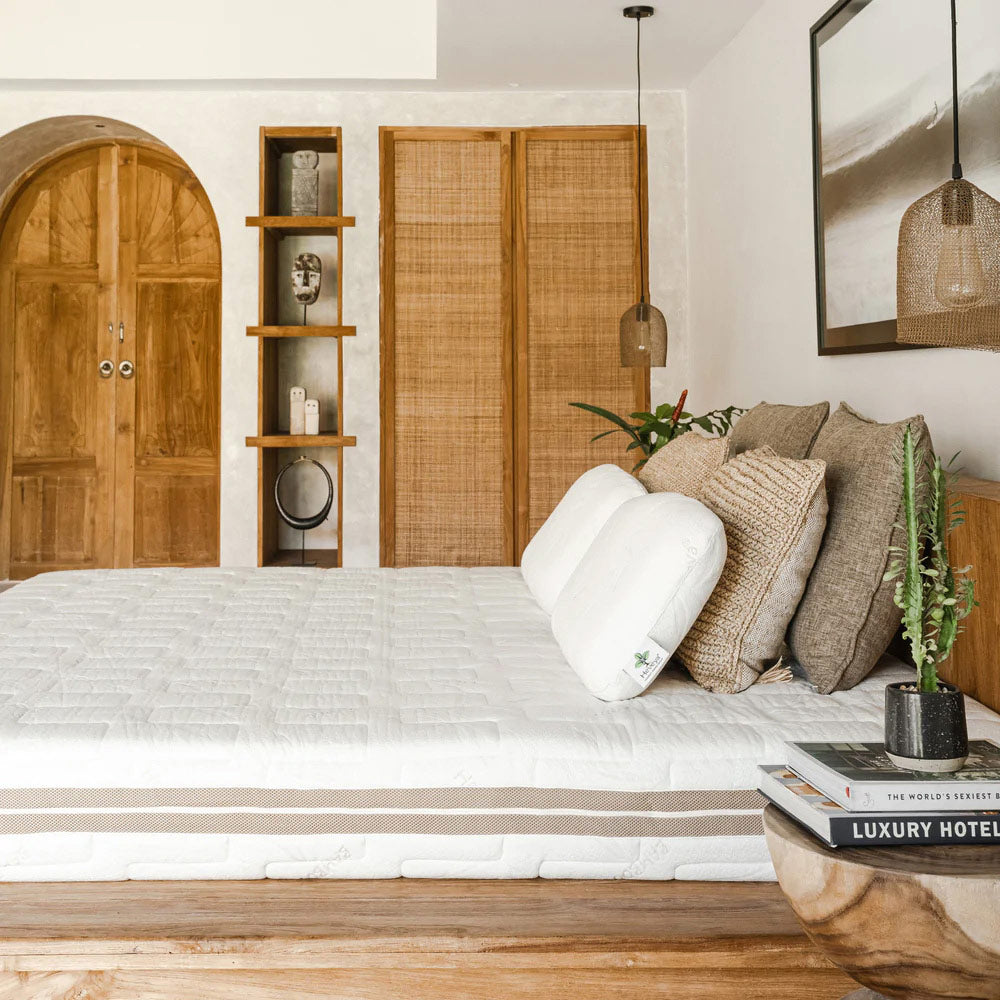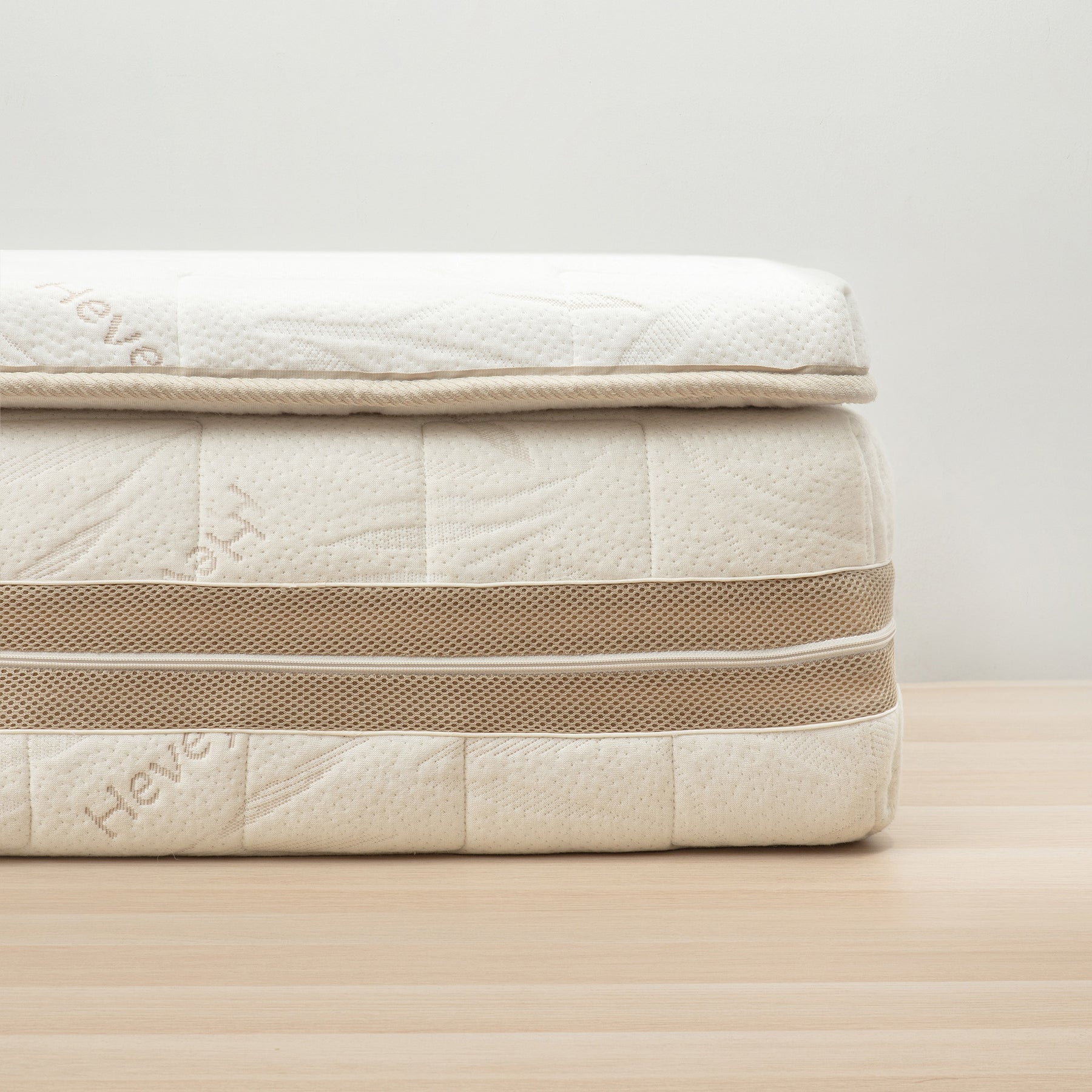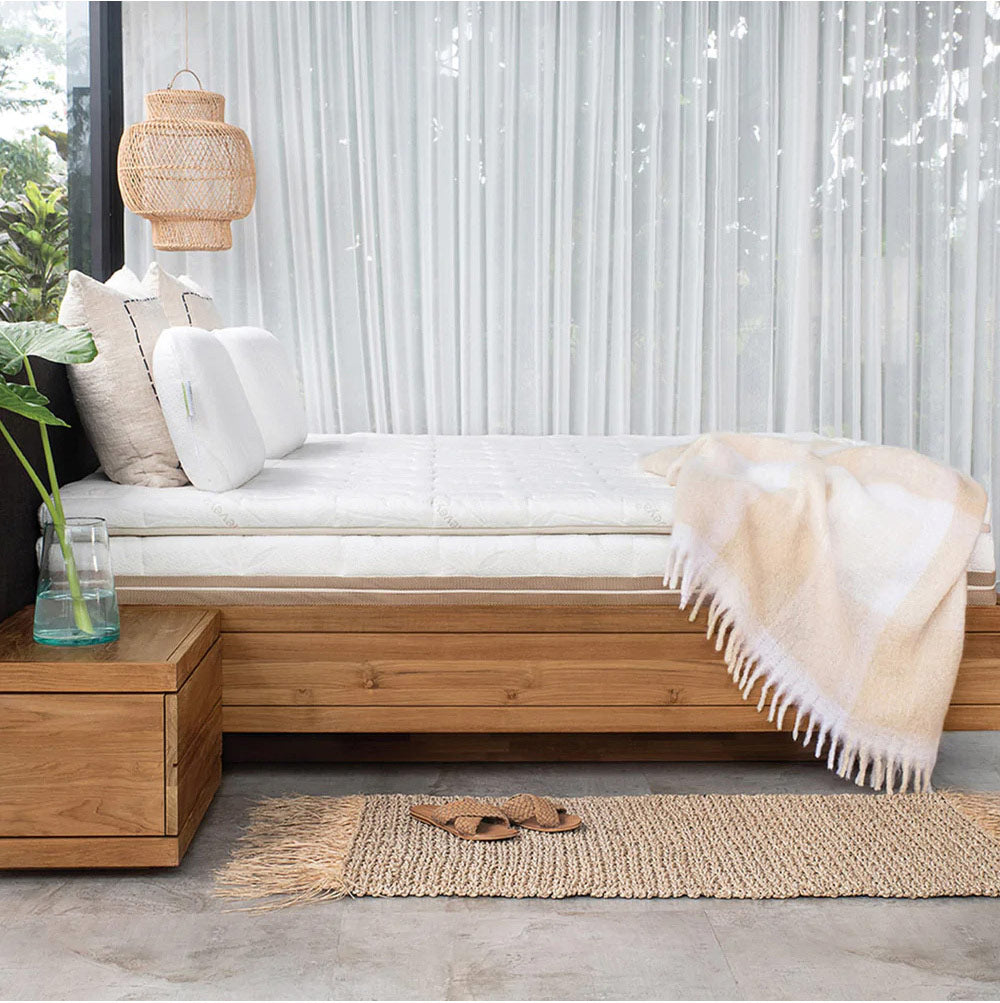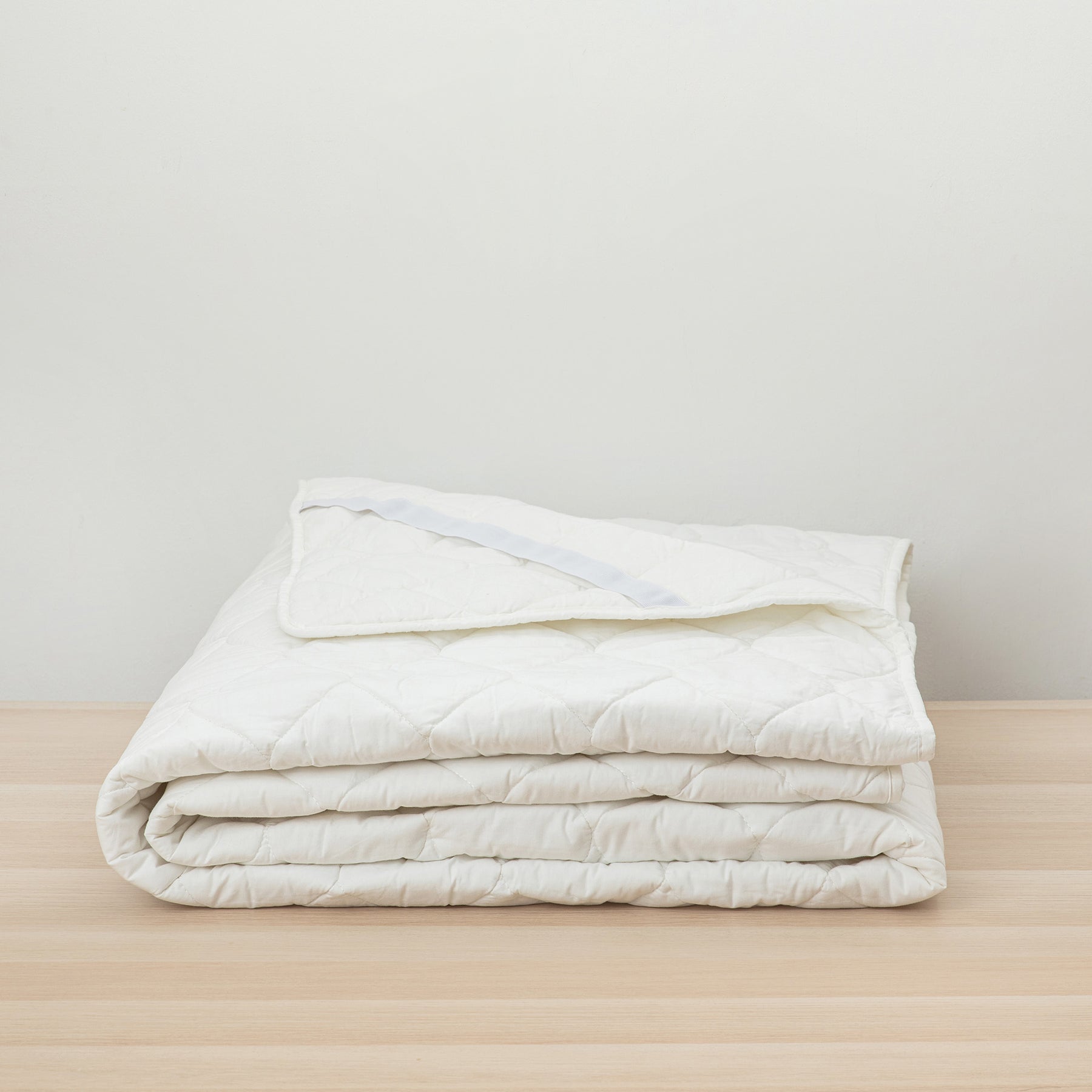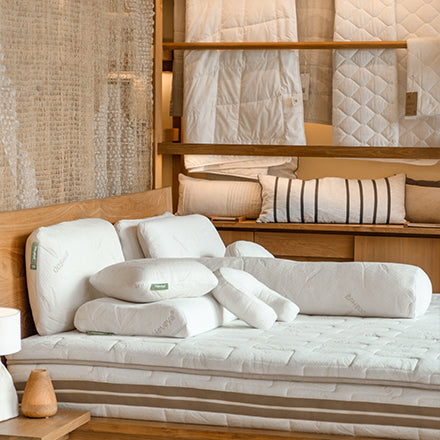If you are thinking of purchasing a latex mattress, you have made a good choice already. Latex offers a truly wonderful combination of support and comfort which owners love. Benefits go beyond comfort; the natural mould resistance, excellent airflow and natural origin of the latex mattress are highly regarded by many.
Indeed, as testament to its relaxing properties, many with back pain find that a latex mattress is by far the best in offering relief.
But beware: not all latex mattresses are created equal. With the huge array of options available, the market can seem bewildering. Rest assured this latex mattress buying guide will help show you what is (and what is not) important in purchasing a good latex mattress.
What is Latex Foam Anyway?
Before comparing the labels, let's quickly touch on the basics. What is this bouncy stuff we call latex foam? Ever wonder where mattress latex comes from? It starts as a milky white liquid sap tapped right out of rubber trees, called Hevea Brasiliensis trees. This natural sap is the key ingredient for that bouncy mattress foam.
Of course, raw tree sap isn't mattress-ready. It needs processing. The liquid latex is mixed with curing agents and then baked in a mould. This process, called vulcanisation, turns the liquid into the stable, elastic foam used in bedding.
So why do people enjoy latex mattresses? Latex foam has several great natural properties: unique buoyancy (springy, responsive feel), excellent support & pressure relief (moulds to body, helping keep spine aligned while cushioning pressure points), durability (incredibly resilient, can last for many years without sagging), and breathability (natural open-cell structure lets air circulate, helping dissipate heat and moisture).
Unpacking the Labels: Blended vs Natural vs Organic Latex
Firstly, there is the origin of the latex: natural or synthetic. Understanding these terms helps you know what you’re really buying when looking at latex mattress types.
Blended Latex: The Budget-Friendly Mix
First up is blended latex. As the name implies, it’s not purely from the rubber tree. What it is: basically, it's a blend. It mixes some natural latex (from rubber trees) with man-made latex. The man-made bit is usually a type called SBR, which is based on petroleum. The amounts in the mix can vary. Its primary purpose is cost-saving.
This results in the following pros and cons:
Pros: generally the most affordable latex option; can still offer some latex bounce; potentially consistent feel.
Cons: less natural material means fewer pure latex benefits; contains petroleum chemicals; potential for more initial off-gassing smells; may not last as long as high-percentage natural latex.
Note that mattresses are either all-natural, or a natural/synthetic blend of latex. In practice, there are no all-synthetic latex mattresses.
A natural/synthetic blend of latex mattress isn’t necessarily inferior compared to an all-natural latex mattress. Most leading latex mattress manufacturers still continue to develop and manufacture natural/synthetic blends of latex mattresses. By mixing synthetic latex with natural latex, they are able to manipulate and achieve the ‘perfect mattress’ that is superior in both comfort and support, consistently.
Natural Latex: Straight from the Tree
An all-natural latex mattress is where the latex comes solely from the rubber tree, Hevea brasiliensis. This foam is made almost entirely from rubber tree sap, making it the go-to for those wanting a more natural sleep surface without needing full organic certification. It's important to clarify that turning sap into foam requires a few processing aids, so 'natural' latex isn't 100% pure sap in the end. However, quality natural latex must contain at least 95% natural rubber, so be wary of vague labels like "made with natural latex".
While an all-natural latex mattress tends to be more expensive than blended latex, it is much more eco-friendly and offers fantastic natural elasticity, support, and bounce. It is also highly durable, naturally breathable for cooler sleep, has less potential for chemical smells, and is naturally hypoallergenic. The main drawback, aside from the higher cost, is that the term "natural" isn't as strictly regulated as "organic," so the quality can vary between manufacturers.
Organic Latex: The Top Tier for Purity and Peace of Mind
An all-natural latex mattress may also be organic. In terms of performance, the organic is equivalent to natural latex. Organic latex is natural latex, but produced under much stricter, certified guidelines from farm to factory. At the farm, rubber trees must be grown on plantations following rigorous organic farming standards, with absolutely no synthetic pesticides. In the factory, processing the sap into foam also meets strict organic criteria, often limiting processing agents. The proof that these standards have been met is that genuine organic latex requires certification.
The most recognised global standard is GOLS (Global Organic Latex Standard). Look for this logo! It guarantees the latex meets strict environmental/social criteria and contains at least 95% certified organic raw latex. Other labels like eco-INSTITUT can complement GOLS. Its appeal lies in the organically sourced nature of the product, which provides the highest purity by minimising chemical exposure, is the most eco-friendly option, and offers exceptional durability and comfort. It is also biodegradable and provides peace of mind through verifiable certification. The main trade-off for these premium qualities is the cost, as an organic latex mattress is typically the most expensive type due to its stringent requirements and certification fees.
As a consumer, if you decide to purchase a natural/synthetic blend or an all-natural latex mattress, just make sure that the bedding store is able to show you the various certifications the mattress has obtained. These certifications are important as they indicate that the latex mattress has undergone rigorous testing of international standard, such as Oeko-Tex, Eurolatex, LGA and Morton Thiokol - to certify that the latex core excels in durability and elasticity, does not contain any harmful substances and poses no risks to the sleeper and the environment.
Processing Method: Dunlop versus Talalay
Latex (whether natural or blended) can be processed in one of two different ways to create the latex blocks for mattresses. One of these is the Dunlop method, which is the simpler, older process. It essentially involves mixing the liquid latex, pouring it fully into a mould, and then baking it. The other method is the Talalay method. Crucially, it's important to understand that Talalay is not a type of latex material itself, but rather a specific and more complex manufacturing process used to create the foam.
It's not important for us to know all the chemistry behind these methods. However, it is important to know that they result in slightly different mattress properties. The Dunlop method creates a denser and often firmer foam that can be denser at its base. In contrast, the Talalay method results in a softer-feeling foam with a more consistent cell structure and is a little more expensive to produce.
The Talalay process is more complex: involves partial fill, vacuum seal, flash freezing, and vulcanisation. What this talalay process achieves: due to the vacuum and freezing, talalay latex generally feels different from dunlop: softer & bouncier (often feels lighter and more 'buoyant'), more consistent (very uniform density), and more breathable (creates more open cells, improving airflow).
This is not a case of one method being superior and one inferior, but instead, a situation where each person will have their own preference. Because it tends to be denser and firmer, Dunlop latex delivers excellent support, ideal for mattress cores. Talalay is often used for top comfort layers due to its softer, bouncier feel and superior breathability. The Talalay process is more complex and energy-intensive than Dunlop, factors that naturally contribute to its higher price.
100% Latex vs Latex with Other Materials

Thirdly, there's the distinction between all-latex mattresses and hybrids that combine latex with materials like PU foam, memory foam, or innersprings. A key reason all-latex is often preferred is its superior durability and resistance to sagging over time. Furthermore, for buyers concerned about off-gassing, the choice is nuanced. While the innersprings in a hybrid mattress do not off-gas, the synthetic foams often paired with them (like PU, memory foam, and even synthetic latex) can emit chemical odours. This positions an all-latex mattress, particularly a certified organic one, as a premier choice for those prioritising both longevity and a sleep environment with the lowest potential for chemical emissions.
While these different types of latex mattresses may seem bewildering to you, simply remember that all-natural or a natural/synthetic blended, 100% latex mattresses are usually considered most desirable. Navigating the latex mattress landscape ultimately comes down to two key decisions. First, select your core material be it pure all-natural or a blend that aligns with your priorities and budget. Second, customise your comfort. Choosing between Dunlop and Talalay isn't a question of quality, but rather a matter of personal taste; it's how you dial in the perfect support and softness for your body.
Firmness Level
You'll need to try out different levels of firmness to decide which one is right for you. Like other mattresses, latex offers various levels of firmness. These range from a soft one which gives you a soft 'sinking' feeling to a very firm mattress.
Do take note that you shouldn’t be confused or overly concerned between firmness and hardness. Firmness is usually measured by mass per unit volume ( kg/m3 ) and hardness is measured either by using kPa (kilo-pascal) or ILD (indentation load deflection). In simple terms, think of density as relating to support and durability, while hardness describes the initial soft or firm feel. You can only determine the right firmness level that suits you best by laying and testing it out.
What Are the Pinholes About?

You have probably noticed from online photos that latex mattresses are punctuated with a series of pinholes. These holes serve two purposes. If you've ever seen a latex mattress, you've likely noticed its surface is covered in a pattern of pinholes. These aren't just for show; they are a fundamental part of the manufacturing process. Think of it like a giant waffle iron: the latex foam is baked in a mould that has a series of pins, which are crucial for ensuring the liquid latex cures evenly all the way through.
But these manufacturing-born holes serve a brilliant second purpose: enhancing the foam's inherent breathability. Natural latex already has an open-cell structure, making it far more breathable than dense synthetic foams like polyurethane (PU). The pinholes then act as superhighways for air, creating a powerful ventilation network. This combination of an open structure and large ventilation channels is precisely why latex is renowned for its ability to stay exceptionally cool, dry, and hygienic.
The second function of the pinholes is to fine-tune firmness and create targeted support zones. While the overall firmness is set by the density of the latex (how much raw material is used), the size and pattern of the pinholes adjust this feel across the mattress.
This allows for sophisticated zoning designed to improve spinal alignment. For example, the mattress can be made softer for your shoulders while providing firmer, more robust support for your hips and lower back.
You won't need to inspect the pinholes to know if this is working. When you lie down, a properly zoned mattress will simply feel more comfortable and supportive. The technology is there to serve your comfort, and testing the mattress is the only true way to judge the result.
Do I Need a Multi-Layer Latex Mattress?
You may have noticed that some latex mattresses are one layer while others are made of two or more layers. This multi-layer approach is a key feature of Heveya® mattresses, which are enclosed in a sturdy, removable cover. Although the mattress looks like a single unit from the outside, you can simply unzip the cover to inspect the individual layers within, giving you full visibility of its construction.
A multi-layer latex mattress offers some added benefits over single layer mattresses. The first of these is personalised comfort. Different levels of softness and firmness can be stacked to create the perfect sleeping experience. These layers can also use different processing methods (like Dunlop and Talalay) to combine specific feels. In stacking layers, the softest layer is usually placed on top for comfort and the firmer layer at the bottom for support.
This versatility allows manufacturers to offer a range of expertly designed models, each with a unique combination of layers tailored for different sleep preferences and body types. The key is not to rearrange the layers yourself, but to find the specific pre-set configuration that provides your body with the ideal balance of comfort and support.

Another significant advantage, specific to premium brands like Heveya®, is the option for future customisation. While most manufacturers permanently glue their layers together, making adjustments impossible, a Heveya® mattress is designed for longevity.
This means if your lifestyle changes down the road, you can simply replace an individual layer for a different firmness level. This unique feature not only extends the functional life of your mattress but also offers a level of future-proofing that glued mattresses simply cannot provide.
When deciding between a single or multi-layer mattress, your focus should be on the overall comfort, not the construction itself. A single block offers simple, consistent support. A multi-layer mattress allows for more complex comfort profiles, like a softer top with a firmer base. The idea of "customisability" is a feature offered by select brands, not a standard for all multi-layer mattresses. Ultimately, lie on them and let your comfort be the only guide.
Do I Need a Warranty?
Yes, a warranty is a must! Don't be tempted to buy a mattress without a warranty: it will be of poor quality. Only buy a mattress which the manufacturer or seller is willing to stand behind with a warranty. A high-quality latex mattress will always come with a warranty period of at least 10 years.
Making Your Choice: A Quick Cheat Sheet for Latex Types and Processes
Feeling clearer? Here’s a simple guide to help you decide on the source material and process:
| Feature | Blended Latex | Natural Latex | Organic Latex (GOLS Certified) |
|---|---|---|---|
| Source | Mix: Natural + Synthetic (SBR) | Mostly Rubber Tree Sap (>95%) | Certified Organic Rubber Tree Sap (>95%) |
| Purity | Contains Petrochemicals | High Natural Content | Highest Purity, Verified |
| Eco-Friendly | Least | Good (Renewable Resource) | Best (Sustainable Farming) |
| Health Focus | Lower | Good (Hypoallergenic) | Best (Minimal Chemicals) |
| Feel | Varies; Can be less 'latex-like' | Good | Excellent |
| Breathability | Okay to Good | Good | Excellent |
| Durability | Good | Good | Excellent |
| Certification | Good | Quality varies | GOLS is the key standard |
| Price | (Most Affordable) | (Mid-Range) | (Premium) |
While different manufacturing processes like Dunlop (firmer) and Talalay (softer) exist, getting caught up in them is a common mistake. What truly matters is not how the mattress was made, but how it feels to you.
The process is the manufacturer's concern. Your concern is finding a mattress that provides the right comfort, support, and quality for your budget. Forget the technical labels and trust what your body tells you.
How to Choose Wisely in a Confusing Market
While understanding the types of latex is helpful, the process of buying a mattress shouldn't be a technical exam. The industry can be intentionally confusing, with complex layers and vague marketing. To cut through the noise, focus on what truly matters: your comfort, proven quality, and the integrity of the company you buy from.
Here’s what sets a truly great mattress experience apart from the rest:
1. Radical Transparency vs. Hidden Layers
Many brands seal their mattresses and pack them with mystery layers, marketing them as "latex" when you can't see what's truly inside. A confident, high-quality brand has nothing to hide. Look for a removable cover. This simple feature is uncommon, but it is your single best guarantee of transparency, allowing you to see the quality of the latex core for yourself.
2. A Focus on Your Well-being, Not a Hard Sell
The right company acts as a guide, not a salesperson. The goal should be to find the mattress that is genuinely suitable for your body and sleep style. This philosophy is proven by the service offered, such as a risk-free 100-day trial, which gives you the time to be certain in your own home.
3. Verified Quality, Not Just a High Price Tag
Don't assume an expensive mattress from a big international brand is made from superior materials. The true measure of quality lies in verifiable certifications (like GOLS, Oeko-Tex, and LGA). These are your proof that the materials are pure, safe, and durable. A high price without certifications is just marketing.
Your Final Checklist:
- Does it feel comfortable and supportive for me?
- Can the company prove its quality with certifications?
- Is the company transparent? (Can I see inside the mattress?)
- Does it come with a risk-free trial and a solid warranty (at least 10 years)?
By focusing on these core principles, you move beyond confusing specs and make a wise, long-term investment in your health and well-being.
Heveya® Latex Mattress: Best Choice for Healthier Sleep
Heveya® Natural Organic Latex Mattresses for durability & comfort. If you are looking for a mattress that embodies the highest standards of purity, comfort discussed in this guide, consider a Heveya® Latex Mattress. Crafted with certified organic latex and other natural materials, they offer superior durability, support, and breathability for a truly healthy sleep sanctuary. Experience the pure, supportive comfort that makes a difference in your sleep health.

Choosing Heveya® means choosing:
- Pure & Healthy Sleep: Certified organic latex and natural materials mean no harmful pesticides or unnecessary chemicals. Better for you, kinder to the planet.
- Tailored Comfort & Support: Organic latex is both soft for comfort and supportive enough to keep your spine nicely lined up while you sleep.
- Naturally Cool & Breathable: The open-cell latex structure plus natural covers promote airflow, helping regulate temperature for undisturbed sleep.
- A Durable Investment: organic latex is incredibly resilient, offering supportive sleep for many years.
- Naturally Hypoallergenic: It naturally keeps dust mites and mould away, which is great for allergy sufferers and means a cleaner bedroom.
Conclusion
Remember that the aim of shopping for a latex mattress is to ensure your utmost comfort. So, enjoy the process of seeking out your perfect mattress! Understanding the basics helps you pick the mattress that's truly right for you, what you like, what you can spend, and what matters most. Choosing a comfy mattress is genuinely looking after your health. Sleep well!
